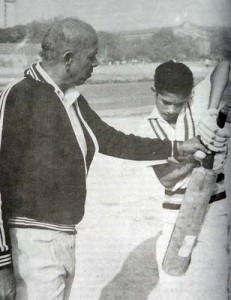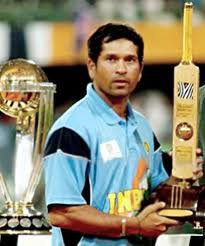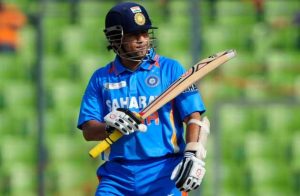Sachin Tendulkar has been nothing but a phenomenon in the world of cricket. Arguably, many would rate him as one of the greatest sportspersons of all time alongside the likes of Roger Federer in tennis, Usain Bolt in athletics, Muhammad Ali in Boxing, Michael Schumacher in Formula One and so on. The main reason for this is his consistency for India in both Test and ODI cricket has been close to impeccable, and greater the consistency means greater the longevity of playing international cricket. Not many cricketers have been able to play more than two decades, with the resurgence of the T20 format and domestic competitions such as the IPL as well as the burnout caused due to more and more matches played these days. But Sachin has successfully been able to overcome those demons and is still very much a part of India’s plans even as they look to build a more youthful side.
Many know that Sachin made his debut for India in Test cricket at the tender age of 16 against a Pakistani attack comprising of Waqar Younis, Wasim Akram and Imran Khan and that too in Pakistan. However, what many do not know is Sachin’s undying passion for the game began at the age of 11. Once he was established as an important member of his coach Ramakant Achrekar’s clubs in Mumbai, he used to literally ‘walk and talk’ cricket. Once his day at school got over in the afternoon, he would straight away head to Shivaji Park and either bat or bowl in the nets literally without any break, usually with much senior cricketers until it became pitch dark. If he had some energy left in him by the end of the day, he would practice batting with a ball hanging on the ceiling in the room. And during the summer vacations, he would literally play the whole day and once he returned home, he went off to sleep sometimes even without eating dinner.

When he was 14 and he had a summer break, he was busy playing non-stop cricket for close to two months. This is just outstanding determination and an early testament of his fitness levels, which have hardly dropped over the years. His passion has resulted in his longevity of playing cricket, which is a quality rare to find in someone who has to make a living, let alone cricketers. One of the best tributes was when Suresh Raina made his Test debut for India in 2010 and it was revealed that he was only 3 years old when Tendulkar made his Test debut.
The 1990s undoubtedly belonged to the batting maestro. The world was losing great batsmen due to retirements, and somebody had to usurp the throne which belonged to the batsman who was the best in the world. Who, after Sir Vivian Richards was the million dollar question. Tendulkar had tough competition from the likes of fellow countryman Rahul Dravid, Brian Lara of West Indies, Ricky Ponting of Australia, Sanath Jayasuriya of Sri Lanka, Inzamam ul Haq of Pakistan and so on.
He managed to overcome that by being consistent in both formats of the game, Tests and ODIs and such was his presence in the Indian team, that when he was not around, opponents could sense that India were resigned to defeat even before the match began. And when he failed in any game, again India could not even think of winning a game. Sachin Tendulkar = India if this is put in a mathematical equation!
Without doubt, he would have to thank the likes of Mohammad Azharuddin, who was captaining India for the most of the 90s and the Indian selectors for being patient with him in the ODI format, in which he scored his first century after 79 matches. But Sachin made his own fortunes and never gave up. For that, Lady Luck smiled at him and made him open the batting in an inconsequential ODI in New Zealand in 1994 when Navjot Singh Sidhu got injured. There was no looking back after that, as Tendulkar piled on hundreds after hundreds and changed India’s future in limited overs cricket.
Although the ICC rankings were not prevalent in the 90s, undoubtedly Tendulkar was the No.1 batsman in the world during the decade. In 1998, a legend such as Don Bradman acknowledged Tendulkar’s greatness by apparently admitting to his wife that he batted very much like him. When Tendulkar met Bradman in Australia in the same year, Bradman wished to clarify whether he was coached in childhood. Tendulkar replied in the affirmative, which shocked the Australian master big time. Bradman was never coached and believed that the technique Tendulkar possesses is never imparted by a coach in his student. It goes to show that the Little Master has always believed in the way he knows how to play the best, while also learning as much as possible from Achrekar. A scientist is more often than not successful when he is original in inventing, and Sachin is one such scientist in the sport called cricket.
He hardly missed a match in the 90s, until he was rested. During the World Cup 1999, his father Ramesh Tendulkar passed away. Yet, Sachin did not let his sadness of losing the person most dear to him come in the way of cricket and on his return to the side, scored 140 not out against Kenya which made India look a completely different side altogether. This shows that even in turbulent times, he can hold his own guard and give it his best for India because the love for playing for his country is the top priority for him and nothing else. If his attitude would have been indifferent, Tendulkar would have been sacked after the disastrous 2007 World Cup campaign in the West Indies.
When it comes to the 2000s, Tendulkar may not go down as the best batsman of the decade because the rigours of international cricket finally took a toll on him and consequently, he had to suffer from injuries. That could also be the reason of his form dipping alarmingly from the period of January 2005 – December 2007. It was during this period that for the first time in his career, he became a victim of ‘failure’. He realized that he had to strengthen his game even more, if he had to continue playing cricket. Instead of letting failure getting the better of him, he got the better of failure and his amount of runs speaks for itself from the period of December 2007 – March 2011. This is mind blowing considering that he had been in his mid-30s, a time when most batsmen have already lost their reflexes and a reduction in their eyesight is almost a given.
Failures have made Tendulkar the only batsman to have scored 100 centuries in the history of international cricket. But champions play for long not just because of determination to bounce back, but more so because of the determination of changing with time. By the year 2002, Sachin had easily become India’s most experienced player, let alone batsman. So he had to change his batting style which was initially swashbuckling to manoeuvring the ball more. This makes him focus on getting more ones and twos and less frequently getting the odd boundary or the six. India’s fortunes in Test cricket changed as the team won Test matches in England, Australia and Pakistan under Sourav Ganguly and Sachin played match winning knocks in the Headingley and Multan victories. Whereas at home, India’s dominance continued.
It is due to his batting style primarily that he got his highest Test score of 248 against Bangladesh in December 2004 and also hit 241 against Australia in Sydney in January 2004. In Multan, he had hit 194 runs being at the crease until Rahul Dravid infamously decided to declare the innings. Undoubtedly, runs have come thick and fast for Tendulkar in Test cricket as the year 2010 was one of his very best, as he hit close to 1500 runs in the calendar year. Even if India played most of their matches in the Indian subcontinent, credit cannot be taken away from him to end in the top 3 run getters of the year.

Whereas, in ODI cricket he did take time to adjust but found his groove as he prefers to open the batting for India. He was the highest run getter in the 2003 World Cup in South Africa, in which India made it to the final out of nowhere initially. He had a mundane 4 years which followed, in which he suffered from injuries and the tenure of Greg Chappell as coach happened. But he detected that something had gone wrong in his game and for that, he had to be more attacking rather than defensive.
From 2008-2011, Sachin had a dream run in ODI cricket which involved a fighting 175 against Australia in Hyderabad in November 2009. It is definitely in the top 3 of his best ODI innings, reminding many of his Sharjah heroics in April 1998. Unfortunately, India lost that match by 3 runs in what seemed an impossible chase of 350 to win.
And then of course came the magnum opus 200 not out against South Africa in Gwalior in February 2010. It is ideal that the first man to ever score a double hundred in an ODI is none other than Sachin Tendulkar, the highest run getter in ODI cricket. This was a feat which many believed could never be achieved by any batsman in a lifetime. Now that Sachin has done it, his self-confessed disciple and opening partner, Virender Sehwag joined the party and actually went on to break the record last year in Indore against West Indies with his 219.
To have that much of stamina and hunger for more and more runs is incredible and this is why Tendulkar still remains in the Indian selectors’ heads. His lifelong dream was to be a part of the team which won the World Cup, and it was accomplished in April 2011. It was then believed that he had no other reason to play cricket, because he almost has every record when it comes to batting and has tasted the feeling of India being No.1 in Tests and ODIs. Yet, he did not announce his retirement and the calls grew louder following his disastrous outings in the Test series in England and the Tests and ODIs in Australia last season.
2011 was otherwise one of the worst years for Tendulkar. Age seemed to finally catch up with him, and in order to give rookies a chance to play for India, he decided to skip the away and home series against West Indies. He has been far from convincing in the last one year and failed in the Asia Cup and the IPL. Although yes, he did score his much awaited 100th century against Bangladesh in the Asia Cup itself but this was such an uncharacteristic Tendulkar hundred because it came out of nervousness rather than domination. Tendulkar is known to give bowlers nightmares, not having nightmares while facing bowlers.
This is where Sachin is not that perfect to be called ‘God’. Public expectations are massive and he has allowed it to take a toll on him which is probably why it took him so long to get his 100th century. Besides, he deciding to skip series on his own in order to prolong his career will has not gone down too well with many. Sure Tendulkar is a play of high stature who has contributed enormously to the welfare of Indian cricket, but eventually no player is bigger than the team. His melange of entries and exits from the team can affect its balance and actually harm their chances of building a stable environment in the dressing room, looking at the fact that the 2015 World Cup is two and a half years away and India have fallen to the No.5 spot in Test cricket.

Now that he is a part of the Rajya Sabha, Tendulkar’s focus on cricket could very well reduce in the long run since he is also interested to contribute to the country being a politician. Although Sachin has time and again proved his critics wrong, how is he likely to bring back his best form? He has put on a few pounds in the last four months, and that could be the result of lack of practice. Agreed that he wants to spend time with his family, but he could do so even more if he decides to quit the game for good. Or at least one format of the game, say ODI cricket. Good that he does not play T20s, except the IPL!
Philosophically, nothing is permanent in the world. Sachin has to come to terms of his mortality in cricket and the fact that there are youngsters who are capable of playing international cricket, being the future of the Indian team. After all, Sachin came into the Indian team and cemented his place when Raman Lamba was injured and because of his success, Lamba had to retire soon after. It is admirable that Sachin believes that he has a lot more left in him to deliver, but he has to see the big picture now and be happy with his achievements.
But of course he continues to be the son of India and the favourite of the selection committee, which is why he is still playing cricket. There could be commercial reasons as well, since Sachin attracts lot of TRPs and crowds in the stadiums which is the recipe for ‘success’ of the BCCI, which has now become a profit making business. Or the fact that India still needs one senior player to be a mentor-cum-player for them, like Ricky Ponting is to Australia at the moment.
Whatever the reasons, Sachin playing till 45 does not seem to be a feasible idea in the best interests of Indian cricket. He may want to do it for himself and India, but this time he should not be selfish. He has the wisdom to understand what it will take for India to be on top of the sport yet again and he should use that before making such a statement. If he does keep his word, he will easily be the player to have played for the longest period of time for his country and continue to entertain every cricket fan in the world. But it would be better for Sachin to go out on a high rather than a low, even if he is the most worshipped cricketer in the world.

Leave a Reply